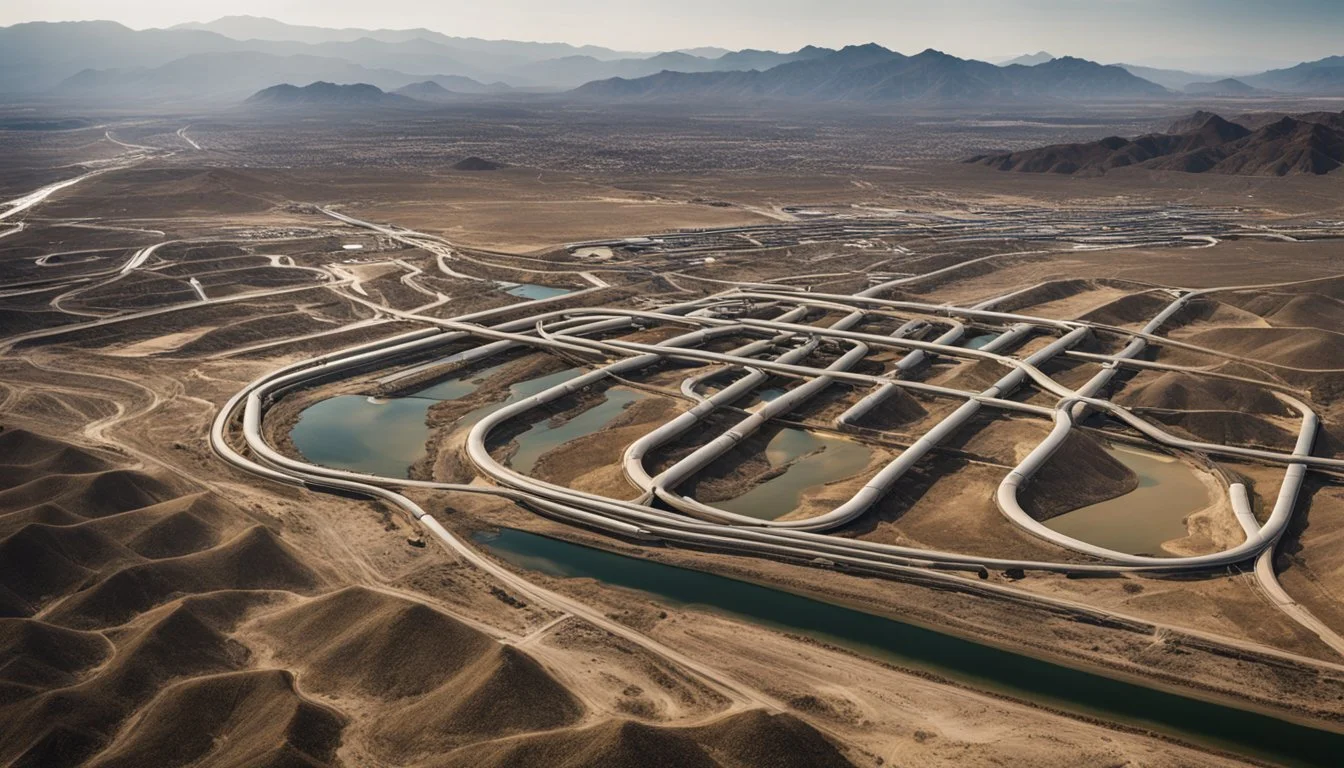LA Times Reporting Explores California Water Wars Inspired by Chinatown
The 1974 film "Chinatown" brought California's complex water history to the silver screen, captivating audiences with its noir-inspired tale of power and corruption. While the movie took creative liberties, it shed light on the real-life water conflicts that shaped Los Angeles and the surrounding region.
California's water wars have been a source of controversy and fascination for over a century, influencing the state's development and sparking ongoing debates about resource management. The struggle for control over water rights has pitted urban centers against rural communities, with far-reaching consequences for both the environment and the economy.
The Los Angeles Times has played a crucial role in documenting and analyzing these water disputes. Its reporting has gone beyond the fictional narrative of "Chinatown" to explore the true stories and ongoing challenges surrounding water allocation in California. This coverage has helped inform public understanding of the complex issues at play in the state's water politics.
Historical Context of California's Water Wars
California's water conflicts have shaped the state's development for over a century. The struggle for water rights between urban and rural areas has been marked by political maneuvering, engineering feats, and environmental consequences.
The Owens Valley Water Grab
In the early 1900s, Los Angeles set its sights on the Owens Valley as a water source. The city quietly purchased land and water rights in the area, often through deceptive means. This acquisition allowed Los Angeles to secure water from the Owens River, 233 miles away.
The water diversion devastated the Owens Valley's agricultural economy. Farmers and ranchers saw their livelihoods dry up as the valley's water was redirected to fuel Los Angeles' growth. The once-thriving Owens Lake became a dusty flat, creating environmental hazards.
This controversial water grab became a symbol of the power imbalance between urban and rural interests in California's water politics.
William Mulholland and the Los Angeles Aqueduct
William Mulholland, the chief engineer of Los Angeles' water department, played a pivotal role in the city's water acquisition. He designed and oversaw the construction of the Los Angeles Aqueduct, completed in 1913.
The aqueduct was an engineering marvel, carrying water from the Owens Valley to Los Angeles entirely by gravity. It allowed the city to expand rapidly, transforming from a small town into a major metropolis.
Mulholland's famous words at the aqueduct's opening - "There it is. Take it." - encapsulated the era's attitude towards water resources. His legacy remains complex, celebrated for his vision but criticized for the environmental and social costs of his work.
Chinatown: The Film as Cultural Narrative
Roman Polanski's 1974 neo-noir classic "Chinatown" has left an indelible mark on American cinema and popular understanding of Los Angeles' water history. The film's blend of fictional storytelling and real historical events shaped public perceptions of California's water wars.
Jack Nicholson's Role and Influence
Jack Nicholson's portrayal of private investigator J.J. Gittes anchors the film. His character navigates a complex web of corruption and deceit surrounding LA's water supply. Nicholson's nuanced performance brings depth to Gittes, a cynical ex-cop drawn into a case far larger than he initially realizes.
Gittes' journey from confident detective to disillusioned observer mirrors the audience's growing understanding of the city's dark underbelly. Nicholson's iconic delivery of lines like "Forget it, Jake. It's Chinatown" has become firmly embedded in film history.
Roman Polanski's Direction and Vision
Polanski's meticulous direction creates a richly atmospheric depiction of 1930s Los Angeles. His attention to period detail and use of sun-drenched cinematography evoke a sense of nostalgia tinged with foreboding.
The director's decision to frame the water conflict through a noir lens adds layers of intrigue and moral ambiguity. Polanski's visual storytelling techniques, such as revealing information through Gittes' perspective, draw viewers into the investigative process.
His unflinching approach to the film's darker themes and shocking climax leaves a lasting impact on audiences.
Fictionalizing Historical Events
"Chinatown" blends fact and fiction, drawing inspiration from the real-life California Water Wars. The film's fictional water department conspiracy echoes actual events surrounding the Owens Valley water rights controversy.
This fictionalization of history has both benefits and drawbacks. It brings attention to important historical issues, but also risks oversimplifying complex events. The film's dramatic narrative has, for many, become the definitive account of LA's water acquisition.
While not entirely historically accurate, "Chinatown" succeeds in capturing the essence of power struggles and corruption that characterized early 20th century Los Angeles development.
Conflict and Conspiracy in Water Distribution
California's water distribution has long been a source of intense conflict and allegations of conspiracy. Power struggles and intrigue surround the control of this precious resource, while conspiracy theories abound regarding its management.
Intrigue and Power Struggles Over Water
Water rights in California have sparked fierce battles between urban and rural interests. Los Angeles' rapid growth in the early 20th century led to aggressive tactics to secure water supplies. City officials secretly bought land and water rights in the Owens Valley, diverting water through an aqueduct to L.A.
This move devastated the Owens Valley's agricultural economy. It also set the stage for decades of conflict between Northern and Southern California over water resources. Politicians and business interests continue to clash over water allocation to this day.
The film "Chinatown" dramatized these historical events, highlighting the corruption and backroom deals involved in L.A.'s water grab. While fictionalized, it captured the real-world intrigue surrounding California water politics.
Conspiracy Theories in Water Management
Allegations of conspiracy have swirled around California water management for decades. Some claim powerful agricultural interests manipulate water policy for their benefit at the expense of urban areas and the environment.
Others point to supposed secret agreements between government agencies and corporations to control water supplies. These theories often involve claims of deliberate water shortages or environmental damage to drive up prices.
While many of these claims lack evidence, they reflect deep public mistrust in water management. The complex, often opaque nature of water rights and distribution fuels speculation about hidden agendas and corrupt practices.
Real instances of misconduct, such as the Owens Valley water grab, have only reinforced suspicions of ongoing conspiracies in water management.
The Plight of the Owens Lake
Owens Lake, once a vibrant ecosystem, fell victim to Los Angeles' thirst for water. The diversion of its water sources led to environmental devastation and social upheaval in the surrounding areas.
Environmental and Social Impact
The draining of Owens Lake caused severe ecological damage. As the lakebed dried, it became the largest source of dust pollution in the United States. This dust contained harmful substances like arsenic and cadmium, posing serious health risks to nearby communities.
Farmers in the Owens Valley faced economic hardship as their agricultural land became increasingly arid. Many were forced to sell their properties, leading to a significant population decline in the region.
Wildlife that depended on the lake's ecosystem suffered greatly. Migratory birds lost a crucial stopover point, and native fish species disappeared entirely.
Restoration Efforts and Continuing Controversies
In recent years, efforts to mitigate the environmental damage have gained traction. The Los Angeles Department of Water and Power has implemented dust control measures, including shallow flooding and vegetation planting on parts of the lakebed.
These restoration projects have shown some success in reducing dust emissions and creating new habitats for wildlife. Some migratory birds have returned to the area, utilizing the newly created wetlands.
However, controversies persist. The cost of these mitigation efforts is substantial, and debates continue over who should bear the financial burden. Some local residents argue that more comprehensive restoration is needed to fully address the ecological and economic impacts of the lake's draining.
Legal and Ethical Aspects of Water Rights
Water rights in California are governed by a complex system of laws and regulations. The state follows both riparian and prior appropriation doctrines, which can sometimes conflict.
Riparian rights allow landowners adjacent to water sources to use that water on their property. Prior appropriation, on the other hand, operates on a "first in time, first in right" basis.
Farmers often rely heavily on water rights for irrigation. However, disputes arise when water is scarce, pitting agricultural needs against urban demands and environmental concerns.
The Public Trust Doctrine adds another layer of complexity. It requires the state to protect certain water resources for public use, potentially limiting private rights.
Ethical considerations come into play when allocating limited water resources. Questions arise about prioritizing human needs versus ecosystem health, and balancing economic interests with long-term sustainability.
Legal battles over water rights are common in California. Courts must weigh competing claims and interpret complex water laws, often with significant economic and environmental implications.
Recent legislation has aimed to improve water management. The Sustainable Groundwater Management Act of 2014, for example, requires local agencies to develop plans for long-term groundwater sustainability.
Impact on Modern Water Policies
The legacy of California's early water wars continues to shape modern policies and practices. Los Angeles remains vigilant in securing its water supply, investing heavily in infrastructure and conservation efforts.
Water rights and allocation remain contentious issues in California. The state has implemented stricter regulations on water usage, especially during drought periods.
Groundwater management has gained increased attention. New laws require local agencies to develop sustainable groundwater management plans to prevent overexploitation.
Environmental concerns now play a larger role in water policy decisions. Efforts to protect ecosystems and endangered species often conflict with urban and agricultural water needs.
Water recycling and desalination projects have gained traction as alternatives to traditional water sources. Los Angeles has set ambitious goals for local water sourcing to reduce dependence on imported water.
Climate change has added urgency to water policy discussions. Planners must account for changing precipitation patterns and increased water scarcity in long-term strategies.
Public awareness of water issues has grown significantly. Conservation programs and education initiatives aim to foster a culture of water consciousness among residents.





